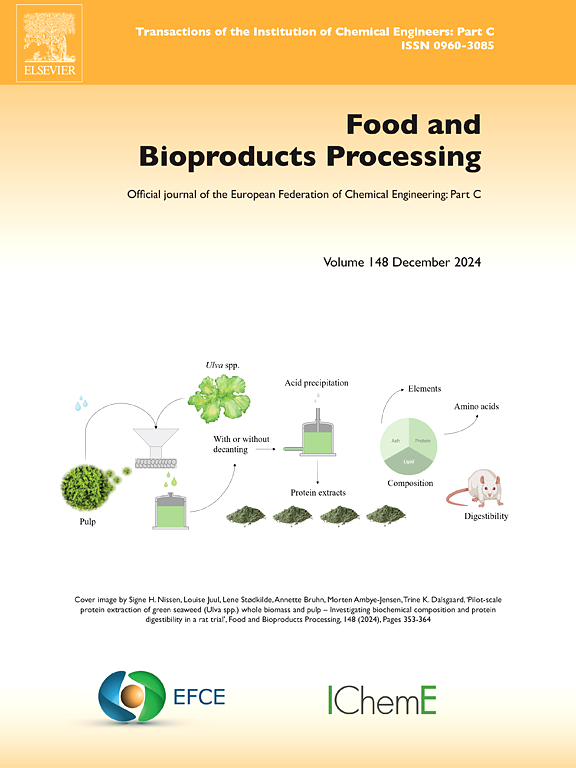Storage stability, release characteristics, and bioaccessibility of the tocotrienol-rich fraction encapsulated in maltodextrin-starch sodium octenyl succinate microcapsules
IF 3.4
2区 农林科学
Q2 BIOTECHNOLOGY & APPLIED MICROBIOLOGY
引用次数: 0
Abstract
Microencapsulation of hydrophobic bioactive compounds offers potential advantages for storage stability, release characteristics, and bioaccessibility. This study utilized a wall material comprising maltodextrin and starch sodium octenyl succinate in an 8:2 ratio to encapsulate a tocotrienol-rich fraction (TRF). The TRF was stabilized with an optimized treated pea protein isolate and flaxseed gum complex in a 3:1 ratio over a 13-week storage period at 40°C. Results indicated a slight increase in cohesiveness (5.36 %) and lightness (4.04 %), accompanied by a minor decrease in microencapsulation efficiency (3.32 %), yellowness (19.62 %), and chroma (18.56 %). The reconstituted microcapsules had a particle size of 4.18 ± 0.10 µm and a span of 2.81 ± 0.09. Moreover, the stored microcapsules demonstrated a low peroxide value of 5.40 ± 0.00 mq/kg and degradation of tocopherol and tocotrienol isomers (ranging from 16.45 ± 1.79–20.89 ± 1.20 %). They also remained stable under various ionic strengths and pH conditions. Post in vitro digestion, the microencapsulated TRF displayed higher bioaccessibility (40.81 ± 0.68 %) and release (85.77 ± 1.43 %) compared to bulk oil. These findings indicate the stability of microencapsulated TRF during storage and exposure to different ionic strengths and pH levels while enhancing bioaccessibility and release following in vitro digestion.
麦芽糖糊精-琥珀酸辛烯基淀粉钠微胶囊中富生育三烯醇组分的储存稳定性、释放特性及生物可及性
疏水生物活性化合物的微胶囊化在储存稳定性、释放特性和生物可及性方面具有潜在的优势。本研究利用由麦芽糖糊精和淀粉琥珀酸辛烯基钠以8:2的比例组成的壁材包封富生育三烯醇组分(TRF)。经过优化处理的豌豆分离蛋白和亚麻籽胶复合物以3:1的比例稳定后,在40°C下保存13周。结果表明,微胶囊的内聚性(5.36 %)和亮度(4.04 %)略有增加,微胶囊化效率(3.32 %)、黄度(19.62 %)和色度(18.56 %)略有下降。微胶囊的粒径为4.18 ± 0.10 µm,孔径为2.81 ± 0.09。此外,微胶囊的过氧化值为5.40 ± 0.00 mq/kg,对生育酚和生育三烯醇异黄酮的降解率为16.45 ± 1.79-20.89 ± 1.20 %。它们在不同的离子强度和pH条件下也保持稳定。体外消化后,微胶囊TRF的生物可及度(40.81 ± 0.68 %)和释放度(85.77 ± 1.43 %)均高于散装油。这些结果表明,微胶囊TRF在储存和暴露于不同离子强度和pH水平下的稳定性,同时提高了体外消化后的生物可及性和释放度。
本文章由计算机程序翻译,如有差异,请以英文原文为准。
求助全文
约1分钟内获得全文
求助全文
来源期刊

Food and Bioproducts Processing
工程技术-工程:化工
CiteScore
9.70
自引率
4.30%
发文量
115
审稿时长
24 days
期刊介绍:
Official Journal of the European Federation of Chemical Engineering:
Part C
FBP aims to be the principal international journal for publication of high quality, original papers in the branches of engineering and science dedicated to the safe processing of biological products. It is the only journal to exploit the synergy between biotechnology, bioprocessing and food engineering.
Papers showing how research results can be used in engineering design, and accounts of experimental or theoretical research work bringing new perspectives to established principles, highlighting unsolved problems or indicating directions for future research, are particularly welcome. Contributions that deal with new developments in equipment or processes and that can be given quantitative expression are encouraged. The journal is especially interested in papers that extend the boundaries of food and bioproducts processing.
The journal has a strong emphasis on the interface between engineering and food or bioproducts. Papers that are not likely to be published are those:
• Primarily concerned with food formulation
• That use experimental design techniques to obtain response surfaces but gain little insight from them
• That are empirical and ignore established mechanistic models, e.g., empirical drying curves
• That are primarily concerned about sensory evaluation and colour
• Concern the extraction, encapsulation and/or antioxidant activity of a specific biological material without providing insight that could be applied to a similar but different material,
• Containing only chemical analyses of biological materials.
 求助内容:
求助内容: 应助结果提醒方式:
应助结果提醒方式:


